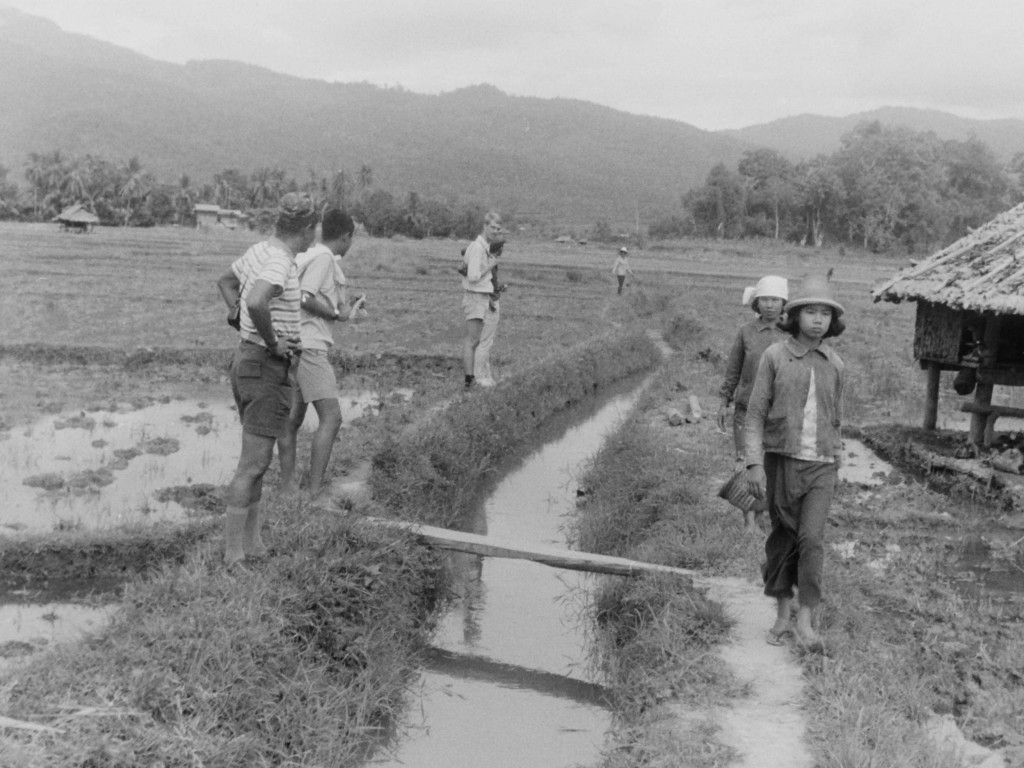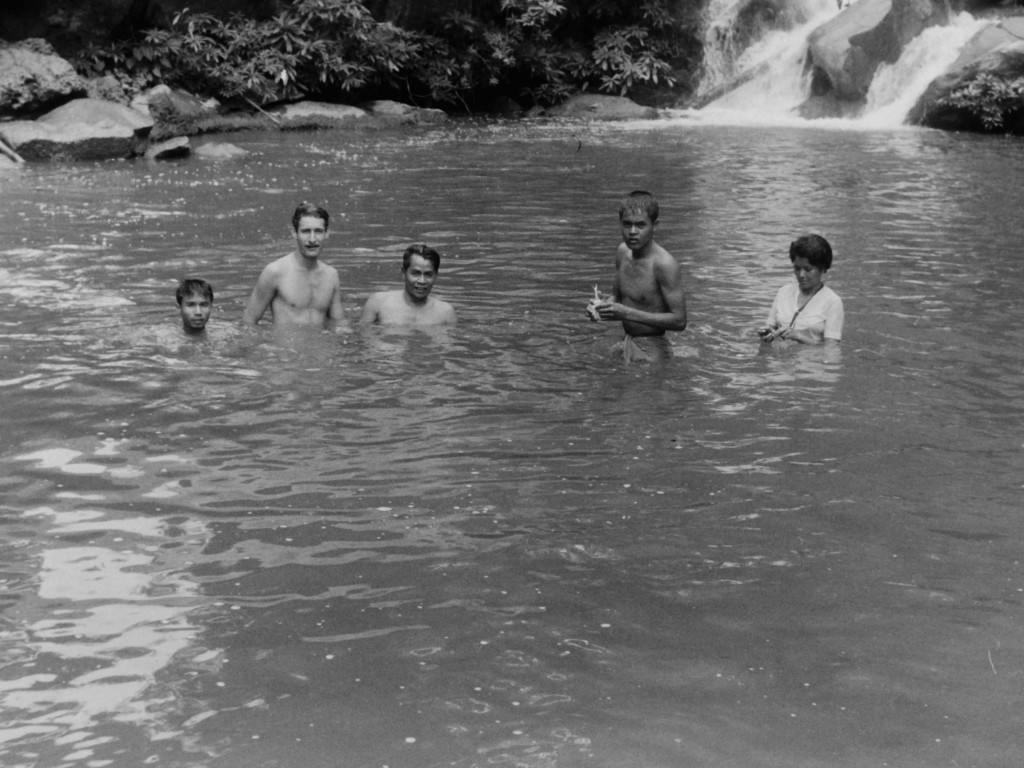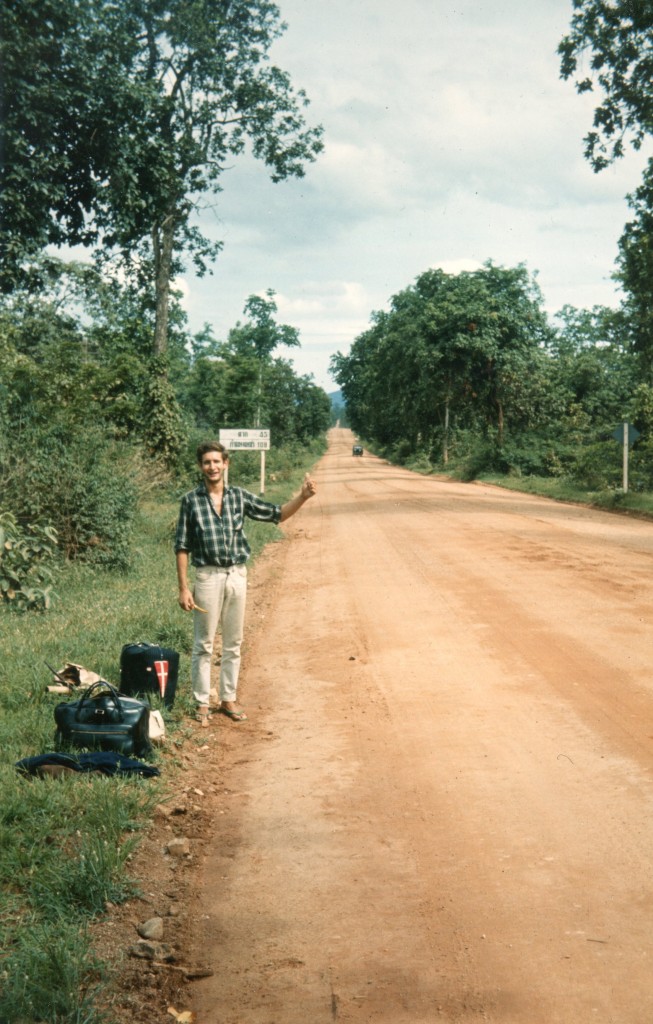Four days stay overnight in Mae Nai Village 18. – 21 july 1966
Text and pictures Erik K Abrahamsen

Click on the pictures and use your zoom control and you will see the pictures in full screen size and text on right side of photo disappear.
I, 20 years old and my travelling companion Niels, 22 years old on our trip “one year around the world” arrived with french passenger ship “Laos” from Colombo, Ceylon via Singapore to Bangkok the 6 th july 1966. After 3 days of sightseeing in Bangkok we travelled by train 750 km north to an old capital of northern Thailand named Chiang Mai, the second biggest city in Thailand with 70.000 inhabitants (1966).
Chiang Mai is founded in a beautiful valley surrounded by mountains up to 14-1600 m all around. 2-300 years ago the city was 2 times conquerored by the Burmese Kingdom. From Chiang Mai there is only 1-200 km to Burma, China and Laos and only 3-400 km to Vietnam.
After 2 days stay in Chiang Mai in a low-priced hotel we met a 40 years old schoolteacher, who invited us to stay in his summerhouse with all his family. He had 4 years ago builded this small house in a banana- and cocunot plot af land only 12 km from Chiang Mai and close to a small village named Mae-rim.
Mr. Suchat summerhouse near Mae-rim, where we stayed as guest with all his family from 11. – 29 july 1966:

Here we stayed as guest with 9 family members of all ages from 11. july until 29. july with 2 breaks to Hill tribe village Mae Nai 18.-21 july and a visit to Mr. Suchat home village near the border to Burma – 125 km from Chiang Mai from 22.-24. july 1966.
Every day we eat traditional thai food and delicacies 3 times a day sitting in a circle together around all the food plates and on our bottoms with crossed legs. In the evening we discussed life and politics and the children sang and danced traditional thai songs and dances.

We all slept directly on the floors on a strawmat under a mosquito net. With no problems. Every day we had so many experiences, that we slept as in heaven and with good dreams!



Mr. Suchat is a specialist in Hill tribes in Thailand and had studied and lived among two different tribes the last 6 years.
He invited Niels and I to visit and stay overnight 4 days in Mae Nai village, where Mr. Suchat had builded a cottage build in the Maew tribe style.
Click on the pictures and use your zoom control and you will see them in full screen size.
Visit to Hill Tribe Village Mae Nai with overnight stay from 18.-21. july 1966:
In Thailand there are about 300.000 hill tribes inhabitants split up into 12 groups with total differences in language and customs. There are differences in clothing, tools, house architecture and religions.
Mae Nai village excits of 12 families, all in all about 100 persons and there are members of the Maew Tribe, which came to Thailand from Laos and South China 2-300 years ago. There founded this village 8 years ago after living in another village since 50 years.
Monday 18. july 1966 I, Niels and Mr. Suchat drove in a jeep 17 km into the mountains and the forest. We left the jeep where the road ended and went on feet through the jungle by small paths in 2 hours before we arrived to Mae Nai village.
In the jungle you can meet tigers, wild elephants, zo jaguars, bears, but there are rare.
More common are apes, wild boars and cobra snakes. We did not meet anything dangerous. Lucky guys!
In a clearing in the jungle Mae Nai village with 12 families turned up!
Mae Nai village in the mountains 18 km from Chiengmai, Thailand:
Click on the pictures and use your zoom control and you will see the pictures in full screen size.

All about 12 houses are situated close to each other on a slope in the jungle. They are all builded by the trees, they have cut down. Each tree had been cutted in width and long pieces, 2-3- cm thick, 20-30 cm width and 1-3 m in length. They are placed as walls with small chinks of 1 cm between planks.
The roof are covered with straw and/or leaves.
The families in the village and from 3-4 neighbouring villages helps each other to build a house. Mr. Suchat had paid people in Mae Nai to build his study house in the original village style. Here we all three lived, eat and slept on a 100 cm raised floor on uprights (posts) the next 4 days.
Niels and Erik in Mae-Nai village:

And by enjoying the beautiful panorama from our cottage I understood, why the Thai Goverment had asked Mr. Suchat to help and educate the hill tribes to understand, what happens with the forest and the soil when they cut new trees down to build new houses and villages and to cultivate new fields every years:
All over on the slopes of the surrounding mountains there are large areas of trees cutted down and with only 1-2 years of agricultural production. Over time that habit will create a problem: The trees that make up the forest and the jungle will disapear and the soil on the slopes of the hills will be swept away in the rainy seasons. That will create big problems in the future!
So Mr. Suchat are here in the village to teach the hill tribes in sustainable development!
Cutting trees on the slopesof the hills for agricultural production:
Click on the pictures and use your zoom control and you will see the pictures in full screen size.

When the hill tribes had cut down an area with trees they start production of rice, corn, maize and opium.
They plant rice on an area and after only one years of rice production, they move to a new place for next years rice production – they dont build terraces for reuse in the rice production!

Family of the medicine man in front of his home in Mae Nai village:
The medicine man in the village is the most prominent person. When there are sick children or sick adults there will visit the medicine man for help, advice and healing.
In the village there are no written rules. Every family takes care of there own affaires. If someone have troubles with other people in the village, there will visit the elder of the village and he will help to solve disputes and problems between the village members. In Mae Nai this elder is the medicine man.
In this area of the White Meaw hill tribe Group which include 3-4 villages med hundreds of members, they have elected a leader (by a hand) for the whole group for period of ten years. This White Meaw Group leader is accepted of the Province Governor of Chiang Mai.
All the silver jewellery are handmade melt down from indian rupee coins with 95% pure silver content.
Click on the pictures and use your zoom control and you will see the pictures in full screen size.

Wife and children of the medicine man in Mae Nai Village:

Fresh and clean water to all houses in Mae Nai village:
From a spring some hundreds meters away the fresh water is led through half cutted bamboos through the whole village directly to all the houses.
Each house has placed a basin of hollowed tree, where a stick to the running water fill up the basin.
Click on the pictures and use your zoom control and you will see the pictures in full screen size.

The medicineman i Mae Nai village clean his opium copper plate:

When we visits the families in their homes, they showed us how they lived and how they use their skills for fabrication of article of clothing and carpentry for house construction.
Husband and wife.
She show us the plant for clothing production and he have just done carpentry work of 2 planks of wood for house building:

And here we all together enjoy the daily life of parents and their children in and outside their homes:
The mothers and their girls sewing ,

– and the boys and their fathers practicing their skills in hunting with their crossbow:

Mother with her child:

The most important event every year is The New Year Celebration.
It is celebrated the first, second and third day after full moon in december.
It is three days where all families come togehter for good food, ancient ceremonies and dance and singing.
All family members, grandparents, parents and children put on their best suit of clothes and their most valuable jewellery.
All the jewellery as necklace, belts and earrings are made of a professional silwer craftsman in the village.
Its melt down from indian rupee silver coins with 95% pure silver. Those indian rupee silver coins were means of payments in northern Thailand in 1940-50.
The white linen clothes are made from a linen plant, which they produce in their fields.
As an honour to Niels and my visit to their village they dressed for photo session of their New Year Celebration suit of clothing:
Click on the pictures and use your zoom control and you will see the pictures in full screen size.


Two girls in their New Year Celebration suit of clothes and jewellary:

22. july 1966 we are back in Mr. Suchat summerhouse i Maerim.
We stayed and enjoyed a social gathering 22. july to 29 july and a visit to Mr. Suchat hometown near the border to Burma, 125 km east of Chiang Mai.
On a day trip on walk to the waterfalls in Maerim District:

Click on the pictures and use your zoom control and you will see the pictures in full screen size.


Swimming in the river at the waterfalls in Maerim District, Chiang Mai:

We finished our holiday in Mr. Suchat summerhouse 29. july and hitchhiked from Chiang Mai to Bangkok 30-31. july – all in all 950 km:

Copyright Erik K Abrahamsen 2011
All rights reserved
Copenhagen, 11. february 2011
To be continued!